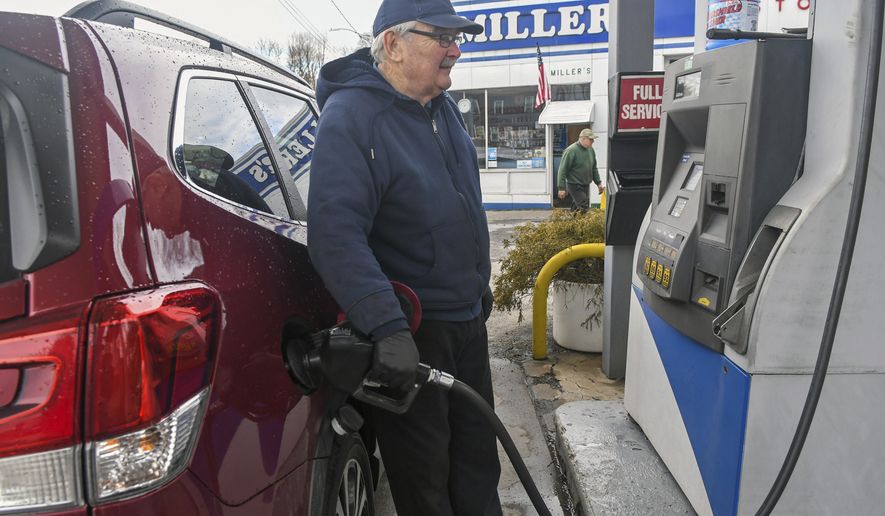Gasoline prices topped $3 a gallon Sunday in nine states and the District of Columbia, part of a steady national rise since November that some analysts expect to hit the $4 mark soon.
Blame the skyrocketing prices on increased demand as Americans emerge from COVID-19 sheltering, coupled with lower supply driven in part by the recent cold snap in Texas that shuttered oil refineries.
Politics in Washington and around the globe can move gas and oil prices, but energy analysts say that’s not what is happening. They also warn that President Biden’s climate agenda likely will exacerbate the rise in fuel costs.
The average price for a gallon of regular gasoline ticked up to $2.85 nationally Sunday, according to AAA.
Retail prices for gasoline and diesel have jumped nearly 30% since November, when the average was $2.20 a gallon.
It’s the sharpest increase since the late 2000s, when motorists had to pay $4 per gallon on average to fill their tanks.
The price at the pump historically has been a roller coaster of seasonal fluctuations and long-term market cycles, but the ride still shocks consumers.
“People are more sensitive to changes in gas prices than any other thing they buy,” said Myron Ebell, director of the conservative Competitive Enterprise Institute’s Center for Energy and Environment. “That’s because the price of gas fluctuates a lot more than nearly any other product, and it’s something that anyone who has a car, which is most Americans, knows about well.”
Several factors are driving the current trend.
First, demand for oil and gas is increasing after nearly a yearlong lull. Americans are beginning to return to a semblance of normalcy as numbers from the COVID-19 pandemic improve. More people being vaccinated against the coronavirus, and rates of infection and hospitalizations are on the decline. Travel restrictions are starting to ease, and more workers are returning to commutes after months of logging on from home.
According to the U.S. Energy Information Administration, demand for gas in March hit the highest level since the onset of the pandemic.
Although demand has grown, supply has decreased. Domestic and foreign oil production remains lower than at any other time in recent years.
In December 2020, OPEC announced that it would be slashing oil production. OPEC said this month that it would maintain those cuts even though oil prices jumped to more than $60 per barrel from a low of $21 a barrel in May 2020.
Overall, OPEC is producing nearly 2 million fewer barrels of oil daily than at this time last year.
Meanwhile, American oil wells and refineries are idle. Since the start of the pandemic, more than 120,000 energy jobs have been lost because of decreased demand for oil and gas. In Texas, alone, nearly 60,000 energy industry jobs were lost in 2020.
With refineries shuttered and half-staffed, some energy companies are struggling to meet rebounding demand.
Domestic energy production further slowed because of severe winter weather along the Gulf Coast, which houses nearly half of the country’s petroleum refining capacity. Texas, which produces more than 4.6 million barrels of oil daily, was forced to halt work at most of its wells and refineries.
All of that has created a perfect storm for higher gas prices.
Consumers are feeling pain at the pump at an inopportune moment for Mr. Biden. Although the president is not responsible for the price hikes, his embrace of policies on climate change is unlikely to provide much relief.
Higher prices for fossil fuels are baked into the administration’s far-reaching goals. The president has reenrolled the U.S. in the Paris Agreement and committed the nation to the goal of net-zero carbon emissions by 2050.
One of Mr. Biden’s first moves in office was to revoke permits for the Keystone XL Pipeline, which would have carried 800,000 barrels of oil per day from Canada to refineries in the Texas Gulf Coast region. He also issued a moratorium on new oil and gas drilling on federal lands.
Both actions likely will hinder attempts to scale up domestic energy production to meet growing demand.
Given the administration’s fight against climate change and the brutal political environment, Mr. Ebell said, voters will likely blame Mr. Biden for higher gas prices.
Mr. Biden might be willing to live with that.
“It’s also in their policy interest to have high gasoline prices … to convince people to get off gas-powered cars and transition to electric vehicles,” said Mr. Ebell. “They really do want high gas prices, in a way, but they have to balance that against the political damage done when gas prices skyrocket.”
• Haris Alic can be reached at halic@washingtontimes.com.




Please read our comment policy before commenting.